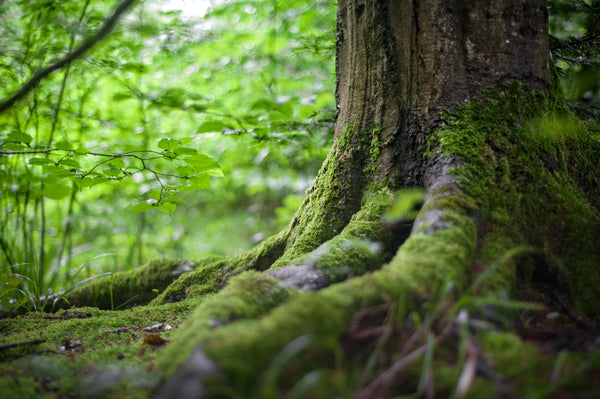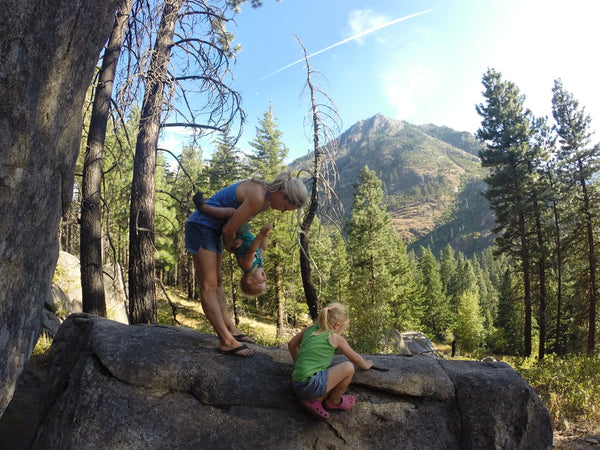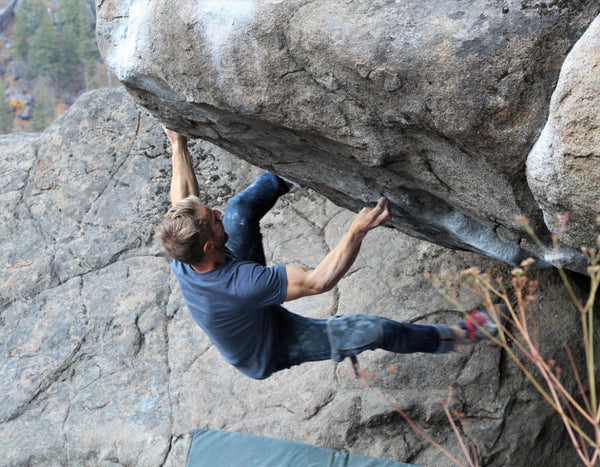FROM CADDY TO CRAG: 9 BOULDERING ESSENTIALS FOR MOUNTAIN STEWARDS

The Mountain Method Boulder Caddy enables you to “PACK less - SEND more!”, but that begs the question: what exactly should you pack?
Trad climbers are used to meticulously racking and re-racking their pro as a matter of life and death, but boulderers tend to be a far more Laissez-faire bunch. Beyond the obvious crash pad to protect our falls, however, are certain bouldering essentials to top off your cragging experience (so you can top out some boulders).
So, now that you have your crash pad and your Boulder Caddy, let’s talk about what to put in it.

1.Your climbing shoes
If there’s one single thing you can’t forget for cragging, it’s a pair (or two or three) of climbing shoes. Unless you’re Vu Nguyen, that is.
Thankfully, the Boulder Caddy comes equipped with not just one but four shoe specific pockets made of stretchy elastic for easy access. Never choose between your toe hooking and heel hooking shoes again!
Since climbing shoes aren’t exactly designed for comfort, and NO ONE likes the hassle of putting on their approach shoes in between burns, comfortable crag shoes are also key to an enjoyable and hassle-free climbing experience. Whether you rock crocs, flip-flops, or slippers, they’ll slide easily into any spare remaining shoe sleeve.
2. Boulder bucket filled with chalk
If you don’t bring an obscene amount of chalk with which to dip your hands into every five seconds, are you even a boulderer?
In all seriousness, chalk is a crucial tool in the climber’s arsenal, whether it’s used for drying wet holds, combatting a humid climate, or ticking that one specific crystal you need to grab to get through the crux of your project.
Bonus points if it’s non-white eco chalk designed to blend in with the rock’s natural color better so you’ll leave just a bit less of a mark that you were there.
Speaking of Leave No Trace, make sure to bring a chalk brush, like the burly Bomber Brush, so you can not only brush your holds, but more importantly brush your ticks when you’re done. Remember, it’s not only what you bring to the crag that matters; it’s what you don’t leave behind when you leave.
Again, the Boulder Caddy makes bringing your brushes a breezy with three brush holders.
3. Area guidebook
Unless you’re a long time local who’s intimately familiar with an area, you’re going to want the wise words of someone who is. A guidebook is key to fully enjoying a crag by providing you not just with ideas about what to climb, but sometimes beta and even tips on how to do safely.

4. Finger warm up tools
Warming up your fingers properly before a bouldering session is key to preventing injury. And if you think the initial days of the pandemic forced an annoyingly long break from bouldering, just wait until you injure a pulley.
While there are several tools (like portable fingerboards) available now to help climbers in this department, a simple set of Crimp Grips are the smallest and most portable of them. Just throw a set or two of these tension rings and bands in your pocket and warm up your fingers on the approach. That’s more time you can spend bouldering!
Be sure to check out this guide of simple exercises to most effectively use your Crimp Grips.
A resistance band is another virtually weightless tool you should bring to help warm up your shoulders, another common place of climbing injury.
5. Skin care kit
As you must care for all the inner workings of your fingers, so too must you care for your skin. Nothing can end a blissful day of bouldering faster than an unfortunate flapper.
Keep your skin smooth and less likely to snag with a simple skin file and nail clippers. If you do inevitably draw blood (or your skin just gets too thin to tolerate touching those crystals for one more go), break out a roll of tape, patch yourself up, and keep on climbing until the tape rips. Retape, climb, repeat.
For these small skin care items, the zippered pouch in the Boulder Caddy works perfectly to keep them secure and in an easy-to-remember location. Because we’ve all said the words, “I know I packed nail clippers in here somewhere.”

6. Snacks and water
You know what they say, “Hydrate or die-drate.”
Even though you spend a lot of time lounging on crash pads when you’re bouldering, don’t mistake that for not working hard. Bouldering is an incredibly energy intensive form of climbing (even if it doesn’t necessarily feel as physically taxing as route climbing). Make sure you keep your body properly fueled with food and water.
If you’re using the Boulder Caddy, it features yet another elastic sleeve similar to those for shoes at the bottom tailor made for water bottles of all shapes and sizes. For protein bars, trail mix, and tubs of frosting (raw sugar is the little known secret to climbing hard)… just toss them in one of the spacious velcro pockets.
7. Wag bag or other waste disposal system
What goes in, must come out. For all those sending snacks you put into your body, you must also be prepared for them to make an untimely exit. But how to do so in a respectful and environmentally responsible manner?
In the wise words of Leavenworth guidebook author Kelly Sheridan, “Don’t make poopy in the boulders.”
While not every crag is as lucky as Leavenworth to have port-a-potties at all major parking spots, that doesn’t mean you get a free pass to leave a landmine under what you think isn’t a very popular boulder.
Depending on the environment you’re in, it’s not only rude to other climbers but potentially dangerous for the ecosystem itself. Human feces already takes a long time to fully break down in nature (think months). Put it in arid, desert environments, like that of Red Rocks, Moe’s, and Bishop, it can’t break down at all. Remember, a big part of being a mountain steward is working “to protect and provide a better and more beautiful environment for the generations to follow”.
That means we need to follow the good old Leave No Trace adage, “Pack it in, pack it out.” To that end, always keep a few wag bags with your climbing gear. Ziplock bags work, too, if you don’t mind a clear view of your leavings. Just make sure you bring the kind that actually zips all the way closed!
8. Extra layers for cold weather
Everyone knows boulderers are some of the most hardcore climbers… okay except for alpine and oddwidth climbers. Why? Because we deal with unpleasantly low temperatures under the small hope that some optimally sticky rubber and cold rock will somehow make our project feel like the grade it supposedly is.
If you’re going to brave the true bouldering season, be sure to bring extra layers, including an extra puffy, gloves, and most importantly, a hat. You may not need a shirt, but every boulder knows a beanie, like the Rainier Beanie, will keep in all the warmth your body needs.
If you're truly chasing those sending temps, you might even want to throw in some hand warmers to keep your tips from going numb.
9. Anything else specific conditions might demand
Is it the middle of summer and you’re escaping the heat of the day with some good old fashioned night bouldering? If so, a headlamp and rechargeable floodlight should be fixtures in your crag kit.
Are you bouldering somewhere that received rain or snow recently? In that case, a simple rag or scrap of cloth for drying wet shoe rubber can mean the difference between actually climbing and waiting for your shoes to dry for five minutes between every burn.
This is all to say finding the perfect list of essentials for bouldering isn’t an exact science. It’s kind of like climbing grades: more of a rough guideline. Certain seasons and locations might demand you bring more specific stuff, so think about the conditions you’ll be facing at your destination.
----
Bouldering may not require the amount of gear of other forms of the sport, but that doesn’t mean we should neglect the gear we do need. Being prepared with all the essentials for bouldering is the first step to being a responsible climber, having fun, and (of course) sending hard.
Thankfully, you don’t need to be too picky about these essentials because the Boulder Caddy has room for all of it and then some.

Leave a comment
Comments will be approved before showing up.
Also in Mountain Method | Blog

6 ways to be more Sustainable | Keep nature green for generations to come
While most people associate mountain stewardship with activities like trail restoration and land preservation advocacy, the basic definition of stewardship is an “ethic that embodies the responsible planning and management of resources”, in fact applies to a much greater environmental awareness.
Crag and trail responsibility are only a small piece of the ‘Protect-our-Planet’ pie. They merely fit inside a larger framework of overall environmental awareness and greenhouse gas reduction (GHG). In other words, being a Mountain Steward is as much about sustainable living habits off the trail as it is on it.
In this article, we'll talk about simple ways to achieve sustainability and counter climate change that keeps nature clean and green!

Bouldering with Kids | The ultimate parent survival GUIDE



Amber McDaniel
Author